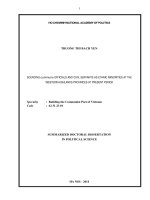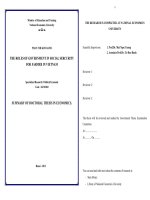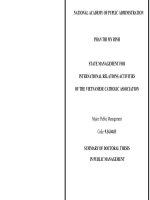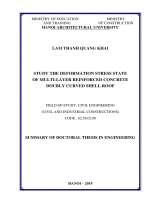Summary of Doctoral thesis in Materials science: Research on fabrication and characteristic properties of zirconium oxide film combination with silane on steel substrate as pretreatment for
Bạn đang xem bản rút gọn của tài liệu. Xem và tải ngay bản đầy đủ của tài liệu tại đây (1.31 MB, 27 trang )
MINISTRY OF
VIETNAM ACADEMY OF
EDUCATION AND TRAINING
SCIENCE AND TECHNOLOGY
GRADATE UNIVERSIY OF SCIENCE AND TECHNOLOGY
----------------------------NGUYEN VAN CHI
RESEARCH ON FABRICATION AND CHARACTERISTIC
PROPERTIES OF ZIRCONIUM OXIDE FILM
COMBINATION WITH SILANE ON STEEL SUBSTRATE AS
PRETREATMENT FOR ORGANIC COATING
Major: Metal
Code: 9.44.01.29
SUMMARY OF DOCTORAL THESIS IN MATERIALS SCIENCE
Ha Noi – 2020
This thesis was done at: Graduate University of Science and
Technology - Vietnam Academy of Science and Technology
Supervisors 1: Dr. PHAM Trung San
Supervisors 2: Assoc.Prof. Dr. TO Thi Xuan Hang
Reviewer 1: .....................................................
Reviewer 2: .....................................................
Reviewer 3: .....................................................
The dissertation will be defended at Graduate University of
Science and Technology, 18 Hoang Quoc Viet street, Hanoi.
Time: .............,.............., 2020
This thesis could be found at National Library of Vietnam,
Library of Graduate University of Science and Technology,
Library of Institute of Materials and Science, Library of Vietnam
Academy of Science and Technology
INTRODUCTION
The urgency of the thesis
Surface pretreatment of the steel substrate before painting had
significant effect on coating adhesion and corrosion protection
performance. Pretreatment not only increases the adhesion between the
paint and the substrate, but also improves the long-term corrosion
protection. Phosphate or chromate pretreatment has been widely used
for this purpose. However, these methods are often increasingly
restricted by international conventions because of several drawbacks
from environmental, energy and process points of view. The trend of
finding alternative methods has been interested in research and
application recently. These conversion coatings are usually transition
metal oxides such as zirconium, titanium, vanadium, molybdenum.
Among them, A promising emerging pretreatment technique is one of
potential replacements for phosphating and one of them is the
application of zirconium oxide or organo-silane. The outstanding
advantage of zirconia is that the film is made of nano properties,
environmentally friendly, cost-saving, simple technology, applicable on
mutli-metal. However, the disadvantage is that it is necessary to use
deionized or ultrafiltration water because the formed film is quite
sensitive to the ions in the washing water and easily forms rust during
stages. Besides, organo-silane is also considered as a promising surface
pretreatment method because of its increased ability to bond between
organic coating and metal substrate and effective corrosion protection.
However, the basic disadvantage of the silane is that it depends how the
surface was treated, the cleanliness of the surface and the density of
hydroxyl group. Therefore, it is necessary to clean the surface well
before pretreatment to promote the effectiveness.
1
A combination of Zr based and silane based pretreatment on
metal substrates in different ways has been performed recently such
as: The hot-dip galvanized steel surface was treated, firstly, with
zirconium nitrate salt then silane; the doped silane pretreatment on
galvanised steel subtrate; Ce-silane-ZrO2 composite coating on 1060
aluminum. The results confirmed that the combined film had higher
corrosion resistance, less porosity, less microscopic cracking and
better pre-treatment than that of each component.
Several methods can be applied to combine between zirconia and
silane. Sol-gel is an atomic scale method which to form zirconia
films with the advantage of high uniformity, the stages of the
reaction can be controlled. However, compared to the chemical
dipping method, sol-gel method requires more stages, higher
temperature, more by-products, it is limited in industrialization. The
zirconia/silane film could also be formed by two steps in two
solutions, however, the one-solution method would allow a simpler
process, at the same time, propose a mechanism for zirconia and
silane to be together formed film on the substrate.
Factors directly related to films forming by the method of
immersion in hexaflorozirconic acid solution could be mentioned as:
temperature, pH, concentration and dipping time. Several studies
have shown that when the temperature of the solution was increased,
the corrosion performance and properties of the zirconia film were
reduced. Solution pH and concentration are two directly correlated
parameters. However, a low concentration hexaflorozirconic acid
solution (with pH of about 3 to 4) usually leaded to a zirconia film
with better pretreatment effect, and when the pH was changed, it
would affect the forming film decisively.
2
Based on the above discusses, with the desire to manufacture a
steel surface pretreatment film which is effective as phosphate and
chromate, the topic of the thesis was chosen: "Research on
fabrication and characteristic properties of zirconium oxide film
combination with silane on steel substrate as pretreatment for
organic coating”.
Goals of the thesis
- Preparing of zirconia/silane combined films on steel subtrate for
organic coatings to replace phosphate and chromate pretreatment;
- Proposing the mechanism of film formation process and
assessing characteristics of morphology, composition, electrochemical properties and bonding of the zirconia/silane film.
Main contents of the thesis
- Research on preparation of zirconium oxide film on steel and
selecting initial conditions on solution pH and dipping time as basis
parameters for manufacturing zirconia/silane film;
- Research on manufacturing zirconia/silane films on steel
substrates; explain the process of formation and their characterization
of morphology, composition, electrochemistry and bonding;
- Study the role of zirconia/silane pretreatment film for powder
coating.
Scientific and application of the thesis
On the scientific side, the thesis has contributed new points in the
research of steel surface treatment films for coatings to replace
phosphates and chromate.
In practice, the results of the thesis are the basis for the
development of technology for manufacturing steel surface treatment
films for environmentally friendly coatings in Vietnam.
3
Detail goals of the thesis
- Preparing of zirconium oxide and zirconium oxide/silane films
on steel subtrate by chemical immersion method.
- Interpreting the mechanism of forming ZrO2/silane film and
describing their characterization of morphology, composition,
electrochemistry and bonding.
- Identifying some basic factors affecting the film forming
process; selecting suitable conditions to form film.
- Manufacturing of zirconium oxide/silane film with high
corrosion resistance, improved adhesion and long-term protection
performance of powder coating compared to zinc phosphate.
CHAPTER 1. OVERVIEW
1.1. The traditional method of steel surface treatment. Overview
of mechanical treatment methods.
Concept, development history, formation mechanism, properties
and technological diagrams of chemical treatment methods:
phosphate, chromate.
1.2. Zirconia-based treatment method: Mechanism of formation,
pretreatment efficiency, characterization and influencing factors;
1.3. Silane-based treatment method: Mechanism of formation,
pretreatment efficiency, characterization and influencing factors;
1.4. Zirconia and silane combined treatment method: Presentation
of several methods were applied to combine between zirconia and
silane; The advantages of these combining methods compared to an
individual method;
CHAPTER 2. EXPERIMENTAL AND METHODS
2.1. Research scheme
4
Preparation of chemicals,
samples and H2ZrF6 solution
Fabrication of zirconium oxide films
Determining the appropriate
conditions of pH and dipping time
according to corrosion resistance
and adhesion
Preparation of chemicals,
samples and solution of
H2ZrF6/silane
Fabrication of
zirconia/silane films
Mechanism of film
formation process
Characterization of
morphology, composition,
electrochemistry and bonding
The influence of dipping time
and silane concentration on
characteristic properties
Adhesion and corrosion
resistance under paint,
long-term protection
performance of coating
Discussion,
conclusion
2.2. Main materials and chemicals
- Carbon steel samples (Quoc Viet Company) were abraded with
SiC polishing paper, degreased, rusted and rinsed with distilled water
and stored in a dehumidifier (bare samples).
- ZrF4 crystal, 99,99% purity, white (Sigma), Silane A-1100: γAPS (China, 99% purity).
2.3. Preparation of surface treatment solution
Preparation of H2ZrF6 solution: ZrF4 was completely dissolved in
HF solution and then distilled water was added into H2ZrF6 acid
solution obtained
Zr4+ = 50 ppm. Preparation of H2ZrF6/silane
solution: Silane A-1100 with different concentration added to H2ZrF6
solution to form H2ZrF6/silane solution.
5
2.4. Methods for substrate treatment of samples
2.4.1. Surface treatment in H2ZrF6 solution
To form zirconia film, the bare samples were immersed in H2ZrF6
solution in a combination of pH varying from 1 to 6, the division was
1 and the time varying from 1 to 6 minutes, the division was 0,5.
2.4.2. Surface treatment in H2ZrF6 solution combined with silane
To form zirconia/silane film, the bare samples were immersed in
H2ZrF6/silane solution in a combination of silane concentration
varying from 0 % 0,05 % (v/v), the division was 0,0125 %, the
time varying from 1 to 6 minutes, the division was 0,5.
2.4.3. Surface treatment with a two steps by immersion
The bare samples were treated in H2ZrF6 solution to form zirconia
film then in silane solution to form silane film (two steps).
After surface treatments, the samples were dried with a dry air
stream (70 ± 3 °C) for about 15 minutes in the laboratory.
2.5. Methods, equipments and technique
EIS and DC were conducted using PGSTAT204N with 3electrode cell in 3,5% NaCl. Frequency: 100kHz10mHz; ± 100 mV.
Scan rate of 1mV/s, step of 1 mV. The OCP were performed during
film formation for 6 minutes.
Surface morphology was investigated by FE-SEM on Jeol 7401F
(Japan). Components and bonds in the film were studied by FT-IR on
Bruker Alpha (Germany) in wave number of 3000500 cm-1, EDS
was investigated by Jeol 7401F and XRD patterns in the following
mode: 2: 20 80o; speed: 0,05o/giây; Cu (Kα) = 1,5406 Å.
To quickly assess the decrease in adhesion and the degree of
corrosion under the incision, the samples were immersed in 3,5 %
NaCl with different exposure time, according to ASTM D 1654-5.
6
Adhesion was assessed by ASTM D3359 (X-shaped incision) and
ASTM D4541 (PosiTest AT-M).
The salt spray testing (JIS 8502:1999) was conducted on Q-FOG
CCT600 (USA): pH: 6,5 ÷ 7,2; NaCl: 5%; pressure: 1,0Atm, temperature:
35 ÷ 37 oC; saturation temperature: 47 ÷ 49 oC; speed: 2 mL/h.
Natural testing was conducted in accordance with ISO 4628: 2016
(Part 8) at the Marine research and testing station, Vietnam - Russia
Tropical Center, Hon Tre Islands, Nha Trang city, Khanh Hoa province.
CHAPTER 3. RESULTS AND DISCUSSION
3.1. Research on manufacturing zirconia film
3.1.1. Effect of pH of hexaflorozirconic acid solution
3.1.1.1. Effect of pH on corrosion resistance of samples
EIS spectrum, polarization curve were at different pHs (Figure
3.1, 3.3) had similar shape but different radians.
Figure 3.1, 3.3. The EIS spectrum and PD curve at different pHs.
Nova 2.0 software, equivalent diagram, capacitance formula:
and Tafel extrapolation were used to identify the
typical parameters (Table 3.1, 3.2). The zirconia film formation has
increased the corrosion resistance. Rp value was higher (Jcorr was
lower) when the pH was between 3 and 5 and reached the largest
value at pH = 4. When pH <3, the acidity was high, Fe was dissolved
quickly and the Zr film if formed was easy also dissolved. When
7
pH> 5 alkalinity increased, the anode reaction decreased, the cathode
reaction slowed, so the pH at the surface-solution interface increased
not enough to form Zr oxide.
Table 3.1. Electrochemical parameters of the film at different pHs.
Parameter
Bare
Rs (Ω.cm2)
pH of H2ZrF6 solution
2
3
4
5
6
72,63
± 0,34
72,86
± 0,31
72,38
± 0,64
74,63
± 0,26
73,40
± 0,49
73,59
± 0,38
Rp (Ω.cm2)
664,29
±14,88
947,04
± 16,65
C (µF.cm-2)
970
660
Y0 (±%)
2177,68 3198,74
± 37,23 ± 46,38
310
280
2438,82 1372,37±
± 41,46
30,31
306
536
0,003643 0,002487 0,000875 0,000993 0,001122 0,001959
± 1,903 ± 1,546 ± 1,650 ± 0,952 ± 1,249 ± 1,700
n (±%)
0,8145
± 0,881
0,8202
± 0,663
0,7855
± 0,596
0,7886
± 0,356
0,8016
± 0,486
0,8250
± 0,708
χ²
0,02798
0,02239
0,02854 0,01311
0,03318
0,03287
Table 3.2. Tafel extrapolation results of samples at different pHs.
Parameter
Bare
E (- mV/SCE)
2
Jcorr (µA/cm )
pH of H2ZrF6 solution
2
3
4
5
6
560,8
633,2
676,4
690,2
683,9
637,6
137
38,8
7,7
7,2
8,0
74
3.1.1.2. Effect of pH on the adhesion of powder coating
Base sample
pH=2
pH=4
pH=5
pH=3
pH=6
Figure 3.4. Adhesion of powder coating at different pHs.
8
Flaking degrees (Figure 3.4) showed that the samples were
treated at solution pH 3 or 4, achieving the best results, the incisions
were almost unchanged (level 5). The rests appeared certain flaking
marks, showing lower levels of adhesion testing.
3.1.2. Effect of immersion time in H2ZrF6 solution
3.1.2.1. Effect of immersion time on corrosion resistance of samples
EIS spectrum, polarization curve of the samples with different
time (figures 3.5, 3.6), datas archieved from EIS, PC (tables 3.3, 3.4).
Figure 3.5, 3.6. EIS spectrum and PD curve with different time.
Table 3.3. Electrochemical parameters of films with different time.
Immersion time
Parameter
Bare
Rs (Ω.cm2)
72,63
± 0,34
Rp (Ω.cm2)
664,29 1151,83 2381,55 3198,74 1953,97 1000,94
± 14,88 ± 25,23 ± 40,25 ± 46,38 ± 49,44 ± 28,83
C (µF.cm-2)
Y0 (±%)
n (±%)
χ²
970
2 mins
3 mins
4 mins
5 mins
6 mins
73,59
± 0,35
73,87
± 0,38
74,63
± 0,26
73,66
± 0,35
75,74
± 0,41
711
679
280
731
1160
0,003643 0,002549 0,002139 0,000993 0,002350 0,003797
± 1,903 ± 1,576 ± 1,6326 ± 0,952 ± 1,2641 ± 1,744
0,8145
± 0,881
0,8268
± 0,699
0,8027
± 0,754
0,7886
± 0,356
0,7915
± 0,667
0,7528
± 0,861
0,02798 0,02740 0,02564 0,01311 0,03512 0,02704
9
Table 3.4. Polarizing resistance and capacitance of the films.
The immersion time
Parameter
Bare
E (- mV/SCE)
2
Jcorr (µA/cm )
2 mins
3
mins
4
mins
5
mins
6
mins
560,8
630,5
649,3
690,2
650,7
634,7
137
16,1
12,5
7,2
16,1
18,1
The formation of zirconia films increased corrosion resistance of
the substrate from 2 to 5 times. Jcorr of treated steel samples were
greatly reduced from 7,5 to 19 times, compared to the bare sample.
As the immersion time increased, the increased Rp value (Jcorr
decreased) because of completing of film formation. But , immersion
time was too much leading to decrease Rp value (Jcorr increased)
because of film was too thick, heterogeneous, cracking due to heat
drying, dehydration.
3.1.2.2. Effect of immersion time on the adhesion of powder coating
Assessment of flaking (Figure 3.7) showed that samples treated
with immersion time from 3 to 5 minutes achieved good results, the
incision almost unchanged (level 5), better than the samples treated
with time of 6 or 2 minutes.
Bare
4 mins
2 mins
3 mins
5 mins
6 mins
t
Figure 3.7. Adhesion of powder coating with different immersion
time.
3.2. Fabrication and characterization of zirconia/silane film
10
3.2.1. Process dynamics and film composition
The trend of OCP (Figure 3.8) showed that the steel electrode was
gradually moving toward the positive side during film formation.
The film was quickly formed within the first 2 minutes, slowed down
until 4 minutes and stabilized to 6 minutes.
Immersion time (mins)
Figure 3.8. Trend of OCP value of bare sample in H2ZrF6/silane.
Initially, when the bare sample was immersed in H2ZrF6/silane,
Fe was oxidized into the solution by anode reaction (Fe-2e→Fe2+).
The Fe2+ ion would combine with ZrF6-2 to release Zr4+ into the
solution (Fe2+ + ZrF6-2 → Zr4+ + FeF6-4). H+ ions were reduced by
local cathode reaction on the surface, releasing H2 (2H+ + 2e → H2↑).
The local pH result on the sample surface increased, resulting in
precipitation of hydrated zirconium oxide. The crystal is germinated
and then spread to the entire surface to form a zirconia film
according to the equation (Zr4++ 3H2O→ ZrO2·H2O +4H+).
Siloxane network formation reactions could also occur:
In silane solution, ethoxy groups switch to silanol group (–
Si(OC2H5)3+3H2O→–Si(OH)3+3C2H5OH). The silanol group was
adsorbed by (Fe-OH) through hydrogen bonding to metal-siloxane
(Si-O-Fe) bonds according to (–Si(OH)3+Fe-OH→H2N(CH2)3
Si(OH)2-O-Fe). Si-OH groups also formed stable siloxane (Si-O-Si)
network by the equation (SiOH+SiOH→Si-O-Si+H2O).
11
The presence of Zr (fig. 3.9b) and Zr, Si (fig. 3.9c) from EDS
spectra proved the phase formation of Zr and Si in the film. The
presence of O also indicated the presence of oxide or hydroxide of
zirconium and the siloxane network. Other peaks may come from the
substrate due to the very thin film.
a)
b)
c)
Figure 3.9. EDS spectrum of bare sample (a), sample treated after
4 minutes in H2ZrF6 (b) and H2ZrF6/silane (c).
Table 3.5. The percentage of atoms in the zirconia/silane film was
determined from the EDS spectrum.
Percentage
Fe
O
C
Zr
Si
Al
Cu
By atoms
77,34 12,65
6,99
2,05 0,76
0,12
0,09
By mass
90,09
1,59
3,85 0,35
0,06
0,11
3,95
The ratio of Zr and Si in the film composition may represent the
formation of zirconia and silane phases (Figure 3.10). Initially, ZrO2
formation speed was very fast, silane film formation speed was very
slow. This result was due to the rapid electrochemical reaction to form
ZrO2 at the beginning, which inhibited the covalent reaction to form
12
silane film on the sample surface. By the time, the ZrO2 film gradually
completed covering the surface, the electrochemical reaction slowed
down and the reaction of form covalent bonds between silane and
metal became easier. Between 1 and 4 minutes, both Zr and Si
concentrations increased, indicating that the two films were formed in
parallel. This meant that silane both competed with Zr in forming film
on steel substrate and created bonds around the newly formed ZrO2.
Figure 3.10. Variations of Zr and Si ratio in ZrO2/silane film.
3.2.2. Surface morphology of zirconium oxide/silane film.
The FE-SEM images of the samples (Figure 3.11) showed that
zirconia film was morphologically arranged with spherical or
elliptical particle structure, tens of nanoscale and irregularly shaped
particles groups randomly distributed on the surface (Figure 3.11b).
Figure 3.11c showed that zirconia/silane film had a finer, more
tightly sealed characteristic.
a)
b)
c)
Figure 3.11. FE-SEM image of the untreated substrate (a), treated in
H2ZrF6 (b) and H2ZrF6/silane (c).
13
3.2.3. Bonding in zirconium oxide/silane film
In FT-IR spectra (Figure 3.12), peak at in 500-600 cm-1 indicated OZr-O bonds. It was reported that Si-O-Zr bonds were usually at 964 cm-1
wavenumber. Affected by the high positive charge of ZrO2, this bond
could be elevated at 1050 cm-1. The peak in the range of 1000-1130 cm-1
was created by the Si-O-Si asymmetric bond, the long vibration and the
separation of this peak showed the laminated structure and confirmed
Transmittance (%)
the bridging role of O between Zr and Si together.
Wavenumber (cm-1)
Figure 3.12. FT-IR spectra in ZrO2/silane film.
The peak around the wavenumber of 1400 and 2900 cm-1 could
represent deformation and asymmetric fluctuations of the –CH group
(-CH2, -CH3). A peak of about 1600 cm-1 was typical for the valence
of the N-H group in silane.
The X-ray pattern (Figure 3.13) showed that one main peak at 2θ =
44,38 and the second peak at 2θ = 64,70 on both the bare sample and
the ZrO2/silane film, which were from steel. The pic at 2θ = 35,26 in
Figure 3.13b was typical for ZrO2 in the film. Only one peak of ZrO2
was obtained because of either the film was too thin, the dominance of
the measurement belonged to Fe. From the Scherrer equation, the
average particle size of ZrO2 was 81,27 nm. This result was quite
similar to the particle parameters achieved by FE-SEM image.
14
Fe
ZrO2
Fe
Fe
Fe
Figure 3.13. XRD pattetn (a-bare, b- ZrO2/silane film).
3.2.4. Effect of silan concentration on morphology, composition
and corrosion resistance of zirconia/silane film
3.2.4.1. Effect of silane concentration on surface morphology
0,0
0,0125
0,05
0,025
2 steps
silane
Figure 3.14. FE-SEM image at different silane concentration
FE-SEM image showed that the presence of silane significantly
improved surface smoothness compared to the case without silane.
3.2.4.2. Effect of silane concentration on film component
The atom ratio of
Si/Zr was shown in
Figure
3.15.
Si/Zr
ratio in the case of 2
steps (0,025%) was
approximately equal
to case of 1-solution (0,0125%) and lower than 1-solution (0,025%)
15
proved that combined film formed simultaneously during film
formation. This ratio increased as the concentration of silane in the
solution increased, reflecting the competition in forming the link
between Zr, Si and steel substrate.
3.2.4.3. The effect of silan concentration on corrosion resistance
The
EIS
spectra
electrochemical
and
parameters
of the film at different silane
concentrations (Figure 3.16
and Table 3.9) showed that
silane doped H2ZrF6 solution
at different concentrations
Figure 3.16. Nyquist spectra at
different silane concentration.
polarization resistance and capacitance of combined film.
Table 3.6. Electrochemical parameters of samples
at silane concentration.
leading to an increase in both
Silane concentration (v/v)
Paramete
r
0
0,0125
0,025
0,05
Rp
(Ω.cm2)
3198,74
± 46,38
5279,68
± 111,40
9116,37
± 279,57
7830,15
± 219,24
7152,84
± 305,43
C (µF.cm-2)
280
422
327
413
321
2 steps
3.2.5. Effect of immersion time on morphology, composition and
corrosion resistance of zirconia/silan film
3.2.5.1. Effect of immersion time on surface morphology
FE-SEM images of the samples with different time (Figure 3.17)
showed that, from 2 to 3 minutes, the film was mainly zirconia, the
surface was still porous and characterized by ZrO2 film.
16
a
b
c
d
e
f
Figure 3.17. FE-SEM image of samples with different time:: 2 mins
(a), 3 mins (b), 4 mins (c), 5 mins (d), 6 mins (e), silane only (f).
After 4 minutes the ZrO2/silane film was almost complete,
however, the silane could still be formed, resulting surface
morphology had silane characterization (Figure 3.17de).
3.2.5.2. Effect of immersion time on film components
Figure 3.18 showed that
the Si/Zr ratio in the forming
combined film increased by
immersion time. At 2 minutes,
this ratio was very low (about
23/100), increased rapidly over
time and reached about 36/100
Figure 3.18. Ratio of Si/Zr with
different immersion time.
and 38/100 respectively with 3 and 4 minutes. In the range of 2 to 4
minutes, this rate increased less, confirming the mutual competition
during film formation.
3.2.5.2. Effect of immersion time on corrosion resistance
The impedance spectrum and electrochemical parameters of the
samples (Figure 3.19 and Table 3.7) showed that the arc's magnitude
corresponded to the polarizing resistance of the film, which increased
with immersion time from 2 to 4 minutes.
17
Figure 3.19. EIS spectra with different immersion time.
Table 3.7. Electrochemical parameters of samples according to
immersion time.
Parameter
Immersion time
2 mins
3 mins
4 mins
5 mins
6 mins
Rp (Ω.cm2)
3198,74
± 46,38
6851,81
± 144,57
9116,37
± 279,57
9080,63
± 277,43
9078,74
± 286,89
C (µF.cm-2)
312
374
327
413
486
3.3. The protection performance of fully painted samples
3.3.1. Adhesion measurement
3.3.1.1. Dry adhesion
The adhesion of the paint film according to the different options
(Table 3.8) proves that all the treated samples have a higher adhesion
than steel. The result is that the zirconia membrane is tightly bound
to the substrate while the silane outside plays a good role as a double
bonding agent.
Table 3.8. The result determines the adhesion of powder coating.
Parameters
Bond strength
values (MPa)
Bare sample
3,04 ± 0,23
Treated in H2ZrF6 after 4 mins
4,20 ± 0,50
18









